Why I put Jay Leno in a Porsche on a NASCAR oval chasing 200 mph
For several heart-stopping seconds, I waited for the sound … the sound of the crash that mercifully never came. Thank you, Lord. I would not be responsible for the death of Jay Leno.
I’m the PR guy who’d persuaded Leno—then at the height of his TV fame—to get behind the wheel of a specially prepared Porsche Carrera GT and attempt a record run at Talladega Superspeedway. From where I was standing on pit wall, I could glimpse only the beginning of his spin, but we’d all heard him sideswipe a cone and were bracing ourselves for something much worse. But I’m getting ahead of the story.
The Talladega escapade happened on September 1, 2005, but I’d hatched the idea for this publicity stunt many months earlier when my employer, Porsche Cars North America (PCNA), was looking for ways to drum up interest in the Carrera GT. Built from carbon fiber, aluminum, and magnesium, and with a midmounted 5.7-liter V-10 engine making 605 horsepower, this was Porsche’s ultimate road-legal sports car, and it brought the German automaker into the supercar realm for the first time. The V-10, suspension, ceramic brakes, and ceramic-composite clutch all were derived from Porsche’s racing experience. Norbert Singer, the longtime chief engineer for Porsche Motorsport, helped develop both the Carrera GT and, earlier in his career, the legendary 917 race car that swept Porsche to multiple victories at the Le Mans 24-hour race in the early 1970s.

Despite the Carrera GT’s impressive pedigree, almost nobody in North America wanted one. By mid-2004, they were literally stacking up at Porsche’s U.S. ports; the company stored them in shipping containers, hoping no one would notice. That didn’t help. Dealers wouldn’t take them, and auction values declined. Blame the price, a whopping $440,000 at a time when even a lavishly equipped 911 Turbo barely crested $150K. A total production target of 1500 units was too high. Ferrari produces far fewer examples of comparable models, but Porsche saturated the market with what could have been an exclusive car. Blame greed, ambition, and the desire to turn Porsche into a profit powerhouse that would rival Volkswagen, the company Porsche ultimately tried to take over in April 2007 by acquiring most of its shares. (That, of course, is another story.)
As the No. 2 PR man for PCNA, I felt keenly the pressure to make a star out of this car, which our bosses at Porsche AG in Stuttgart, Germany, considered the ultimate expression of the brand’s engineering expertise. Corporate—not to mention German—pride was at stake. They couldn’t understand why deep-pocketed American car enthusiasts weren’t lining up for it.

Porsche AG’s high-volume production plans were in stark contrast to everything I’d learned about marketing high-end automobiles. The late Fred Schwab, president and CEO of PCNA from 1992 to 2003, shared the secrets of Porsche’s success during my job interview in 1998. “The product always comes first,” he said, “and we always build one fewer than the market demands.” With the Porsche Carrera GT, the company got the first point right but lost track of the second. Schwab, though, was long gone by the time the Carrera GT was hitting the U.S. market. I was eager to offer solutions for his replacement, Peter Schwarzenbauer, and PCNA’s long-time public relations boss, Bernd Harling. I tried to imagine how we could raise the profile of the Carrera GT and, in the parlance of the car business, move units.
But the Carrera GT was more than a unit to me. It possessed the DNA of the machine that started my fascination with the brand: the Porsche 917. Whether I was behind the wheel of the Carrera GT or just standing next to it, the car made me as giddy as a 10-year-old kid in the theater watching Steve McQueen’s Le Mans for the first time.
The answer, I thought, was simple—racing. Not the best idea given the cost of replacing carbon-fiber panels and structures, but how about a speed record? There was a historical precedent.
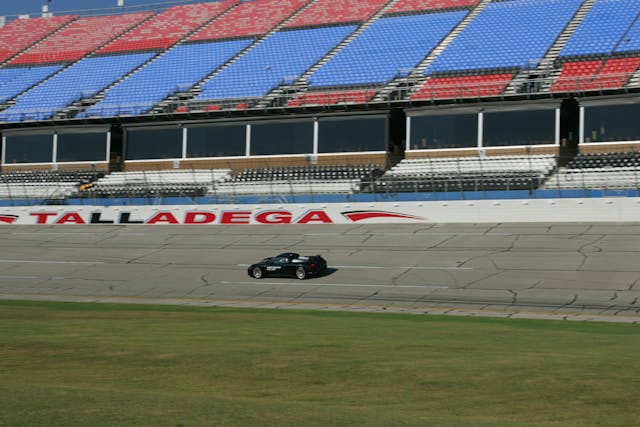
Mark Donohue, my childhood hero, set a closed-course record in a Porsche 917/30 at Alabama’s Talladega Superspeedway in August 1975. (Sadly, 10 days later, he died from a crash while practicing for the Austrian Grand Prix.) I pitched Harling—a German native with strong ties to Porsche AG—on the idea for reprising the 917/30 speed record using a Carrera GT at Talladega. I even wrote a press release for the outcome of the proposed event—a full year before it was to happen—and left it on his desk. I didn’t say another word to Harling. His reply was in his smile, and in a day’s time, we had approval from Schwarzenbauer. The goal was to generate media coverage from both automotive and general media and to equate the Carrera GT in the minds of American car enthusiasts and collectors with the Porsche 917 and other race-winning Porsche machines. Demand would then rise to the abundant supply. No more stowing them in containers!
Left to do was the hard work: legal agreements, insurance policies, logistics, staffing, car setup, and buy-in from countless needed supporters. The natural pick for driving was Mark Donohue’s son, David Donohue, and not just because of his lineage. While working in motorsports PR for Michelin in 1997, I watched David, race by race, sew up the North American Touring Car Championship driving a PacWest Dodge Stratus. That led him to Le Mans, driving the factory-backed Canaska Dodge Viper GTS-R. We met again when I joined PCNA. David had switched to Porsche and was driving for the Brumos team. (He would ultimately win the 2009 Rolex 24 at Daytona driving a Brumos Riley-Porsche Daytona Prototype.) My colleague and friend Bob Carlson, who handled motorsports and automotive media duties at PCNA, invited David to drive the Carrera GT at Talladega.
“It was an honor in one regard; it was really scary in another,” recalled Donohue. “My dad wasn’t around much longer after setting his record. It was just weird. I felt privileged that Bob asked me to do it. I really wanted to do it, and I wanted to do a good job.”
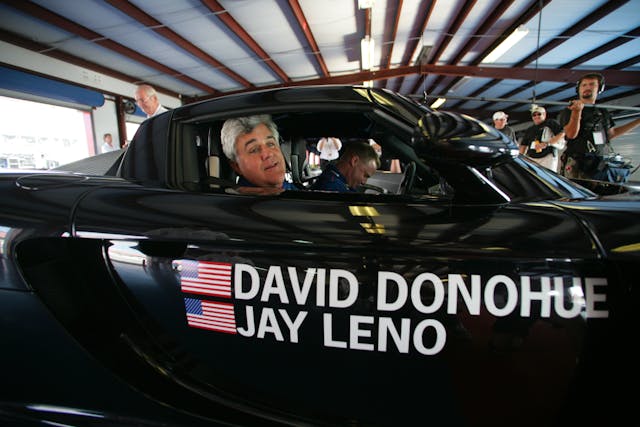
I set about finding someone with star power to share the driving with Donohue. The late Howard Buck, who handled film placement for Porsche for many years, compiled a shortlist. Several years prior, Buck and I had recruited James Brolin to drive across the eastern Mojave in one of two lifted Porsche 911 Carrera 4s. But the Carrera GT event would be different. We needed someone with track experience. There were few such celebrities on the list, but Leno, then host of NBC’s The Tonight Show, and a noted car enthusiast and collector, was one. He was the right choice. To our surprise, he accepted our offer, and we knew his participation would prompt media coverage of all kinds.
With the driver lineup, we chose to pursue two kinds of records, a standing start record and a flying record. The former is timed from a dead stop, the latter from a best possible speed. Since Donohue had the racing experience, he would set the flying records while Leno would handle the safer, slower standing records.
Apart from the nostalgic value, Talladega was ideal for sustaining high-speed laps. Four lanes wide and 2.66 miles long, its turns are banked 33 degrees on each end, with 16.5-degree banking in the tri-oval. The backstretch is 4000 feet long. Long enough and banked enough, we thought, to get us to a flying speed record of more than 200 mph.
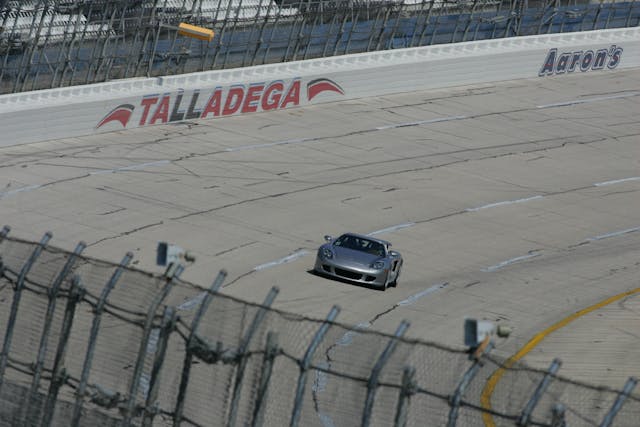
With major decisions made, I conferred with experts at Porsche’s R&D facility in Weissach, Germany, to prepare several cars for the attempt. We wouldn’t simply be plucking them at random from the factory line in Leipzig for an extreme and high-profile exercise like this. The Carrera GTs we used were upgraded with safety equipment, including a five-point racing harness and Michelin Pilot tires on BBS racing wheels designed to handle the forces the car would generate at speed on Talladega’s severe banking.
Much of the chassis and suspension setup was done by the Porsche Service Training team at PCNA headquarters in Atlanta. Led by Bill Verock, that team included Bob Hamilton, Craig Stoyer, and John Beard. During pre-event testing at Talladega, Donohue correctly decided the team needed counsel from an oval expert. He called in Hayden Burvill, an engineer for Brumos, a famous Florida-based racing operation. Burvill also had IndyCar experience. He served as the crew chief and advised the drivers.
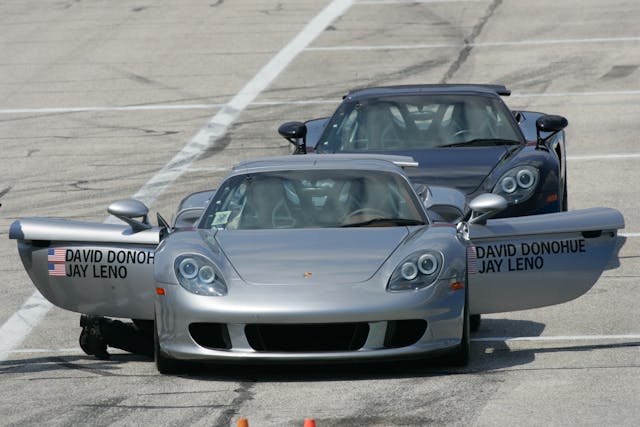
“What concerned us was that if anything happened out there, we were going to get hurt because we were in a road car going 200 mph,” said Donohue. “Talladega is wide, which you think makes it safer, but it’s really not. If you are close to the wall, as on narrow tracks, you’re going up against it and scraping along, but at Talladega, you are going to hit it! If something happened, it was going to be a yard sale. We didn’t have a cage. It wasn’t a race car built for ovals.”
Though Norbert Singer had retired from Porsche AG, he was retained and very much interested in the record attempt. Engineers working on his behalf at the Weissach facility studied loads the car would generate on the banking at Talladega. Advice on ride height, spacer specifications, and settings came via fax. Since the Carrera GT suspension design doesn’t lend itself to quick adjustments, the service team prepared several cars with different setups. Donohue selected the best of them to be the record-setting car.
Excited as the team was about the coming speed record attempt, August brought a plot twist: an announcement from Stuttgart that production of the Carrera GT would end with the requirement for second-generation airbags in the United States. An Automotive News reporter called, wanting detail about why Porsche would stop production of the Carrera GT short of the 1500 units Porsche AG chief Wendelin Wiedeking had promised. I consulted with our counterparts in the Stuttgart office.
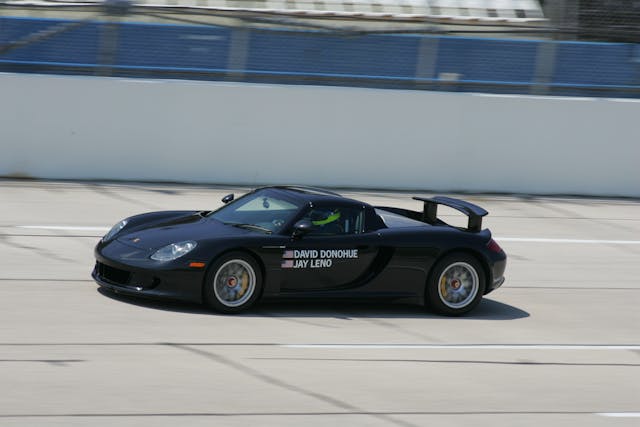
“The National Highway Traffic Safety Administration will not allow Porsche a waiver on second-generation airbags,” was the official answer I was to provide. Unfortunately, that answer did not correspond with facts known to the Porsche compliance department in Atlanta, which had been negotiating with NHTSA to resolve the problem. I weathered that storm, but another was on its heels.
Finally, September arrived. The records would be verified by the Grand American Rolex Sports Car Series, the sanctioning body that organizes the Rolex 24 at Daytona. Grand American series director of competition Mark Raffauf officiated. Like Singer, Raffauf was on hand for the original 1975 record event with Mark Donohue in the Porsche 917/30. Singer also decided to join us at Talladega.
The players converged on Talladega. Leno flew in from California, arriving a day early for a small reception hosted by Birmingham-area businessman, motorcycle collector, and philanthropist George Barber. Both men share a love of motorcycles, and the meeting seemed a natural stop on his visit. Leno eschewed special treatment and food. He entered the hotel at the front entrance, not the private one we had arranged, and greeted surprised clerks, fans, and passersby. After the gourmet reception at the Barber Vintage Motorsports Museum, Leno made one request: “Let’s stop at that Arby’s for a roast beef sandwich!” He spent a few minutes there chatting with the guy at the counter. It was refreshing working with a regular guy after enduring Hollywood celebrities who had bottled water brand preferences. Leno was a joy.
Practice runs started on the morning of September 1, 2005. At the same time, a hurricane named Katrina was pounding the Gulf of Mexico and New Orleans, almost 400 miles to the south.
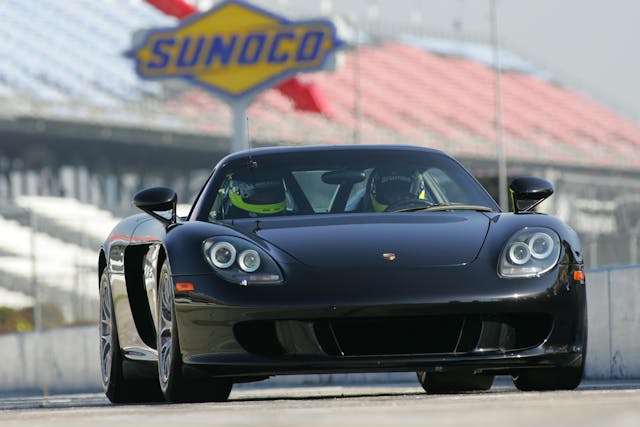
At Talladega, the sun was still shining, but Katrina was on everyone’s minds, and we were all checking the latest weather reports. We’d be spending the morning doing practice runs and getting Leno familiar with the car and the track. As he got in the car, Leno seemed as relaxed about the driving duty as he was talking to the counter guy at Arby’s the night before, but the tension was about to rise.
“We set up the timing equipment to start on the back straight. Where you set up matters for the kilometer and the mile because different parts of the track have different speeds. As it turned out, the faster part of the track was on the front straight, not the back straight, going into Turn 1,” recalled Raffauf. “We had to move the timing equipment. When it was set back up, the only timing line that was working was in the center of the tri-oval—the kilometer line. Leno knew that, so when we were out doing practice runs, he just kept his foot in it; he went in a little high and maybe didn’t turn enough in the beginning, then he crossed the line where timing was set up, got off the throttle, and around he went.”
Raffauf was with me on pit wall for the excruciating seconds after we saw the beginning of Leno’s spin. Fifteen years later, he remembered the scene as vividly as I did: “He spun down near the exit; then there was this big collumph,” he said. “But all he had done was slap-sided the cone down by the timing beacon. Earlier that day, I overheard Donohue giving him some coaching on the track. He said, ‘Jay, if anything happens, just turn left.’ That’s exactly what he did!”
Donohue has his own memories of the incident. “That was really scary. You don’t spin at 200 and get away with it very often, especially going backward,” he said. “He still had a little bit of downforce, but he could have gone airborne. We were lucky he stayed on the ground and didn’t hit anything. I was stunned.” So was I, David. So was I.
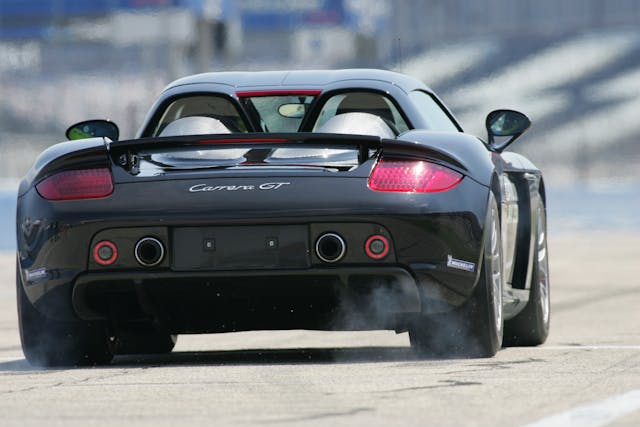
Leno drove the black Carrera GT back to the garage and was noticeably pale. He quickly turned the moment into humor, though, when a crew member presented him with a roll of toilet paper should he need to “clean himself up” after the incident.
Though it was heavily covered by the media and captured on video by a crew for the TLC television program Rides, the spin was not Leno’s most memorable moment from the day.
“I remember looking down at the speedometer and seeing the needle on 192,” said Leno. “That was an unbelievable number. I had never seen it before. It reminded me of when I was a kid and stayed up for the first time really late and looked at the clock and the hands were pointing to 12 midnight.”
The spin behind us, timing lights situated, and fresh Michelins fitted, the team started record runs. Donohue set the flying lap records and Leno the standing records. Both drivers were learning the car and the track at the same time. The car’s suspension setup was optimized—including the springs and ride height at each corner—to deal with the load in the banking, not the flatter tri-oval turn or the straights.
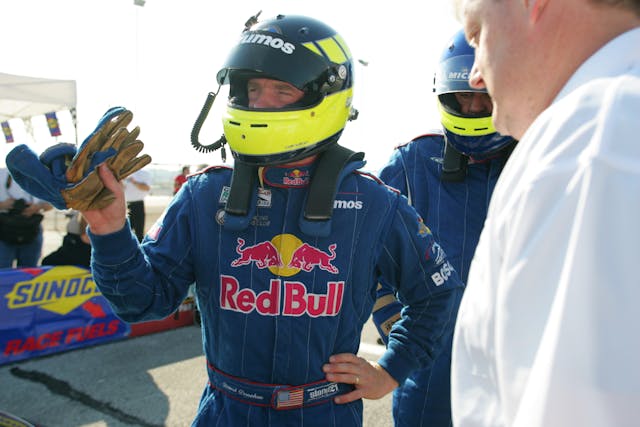
“On a flat surface, the car had whacked-out ride heights. There was a lot of tilt put into the setup,” said Donohue. “We were still bottoming out in the banking because the vertical load was so great, but when we went through the tri-oval, without all that vertical load, the car was kind of floaty, so the tri-oval was the hardest part.
“I ended up getting flat throttle all the way around. The car was not easy flat. It took a lot at that point because it had such an understeer coming out of Turn 2 and a bit of oversteer coming out of Turn 4. I watched an interview with my dad, and he had the same comments when he drove the 917. I was like, wow, same thing in the 917!”
The speeds recorded by the Grand American organization that day are:
David Donohue
- Flying Lap: 196.301 mph
- Flying Mile: 198.971 mph
- Flying Kilometer: 195.755 mph
Jay Leno
- Standing Lap: 156.603 mph
- Standing Mile: 128.944 mph
- Standing Kilometer: 110.478 mph
The elder Donohue had done his flying lap at 221.120 mph in the purpose-built Porsche 917/30 race car—with 1100 horsepower. The headline on the artist’s commemorative poster read, “History Made, History Remembered.” Indeed. “We set the records almost as the sun was setting. We got much faster as the sun went down. It really was temperature-dependent,” said Donohue. “We could have gone faster, I think, if we stayed at it. But Katrina just got worse and worse by the hour. We knew people were really suffering, and there was a somber tone. I remember thinking: What the hell are we doing here?” Porsche, though, needed to wave a banner over the event. That had been the point all along. We took the challenge of Hurricane Katrina in stride.

The headline for the next press release I wrote was: “Jay Leno to Oversee Auction of Record-Setting Carrera GT Donated by Porsche with Proceeds to Benefit Victims of Hurricane Katrina.”
Everyone involved agreed that we should parlay the Carrera GT record into cash for hurricane relief efforts. Leno and Donohue were supportive, along with Harling and Schwarzenbauer. A plan evolved to auction the car at the Petersen Automotive Museum in Los Angeles, with Christie’s overseeing. The date and time were set: November 18, 2005, 7:00 p.m. We invited the car-and-star world of Southern California to take part in a must-attend event.
About a half-hour before the auctioneer was to go on stage, Leno walked toward me—an untouched table of heavy hors d’oeuvres between us—with a look on his face I had not seen before. “Whose idea was it to charge a $100 cover at the door?” I paused for a moment, stunned by his demeanor. “The people at Christie’s,” I responded.
“Don’t you know that rich people didn’t get rich by paying cover charges?” His comment triggered memories of my college American literature studies and a quote from F. Scott Fitzgerald’s “The Rich Boy:” “Let me tell you about the very rich. They are different from you and me…”
The Great American Novel was playing itself out on the rooftop of the Petersen Museum, I thought to myself, with Jay Leno as protagonist. Of course, Leno was right. We had lost potential customers at the door. I felt bad that I had disappointed him because I knew he cared about the outcome—raising money for hurricane victims.
Also sensing the lack of bidders in the room, the Christie’s auctioneer pulled me and my colleagues aside. “We need a mercy bid strategy,” she said. “We need someone who can bid on behalf of Porsche, then leave the room.”
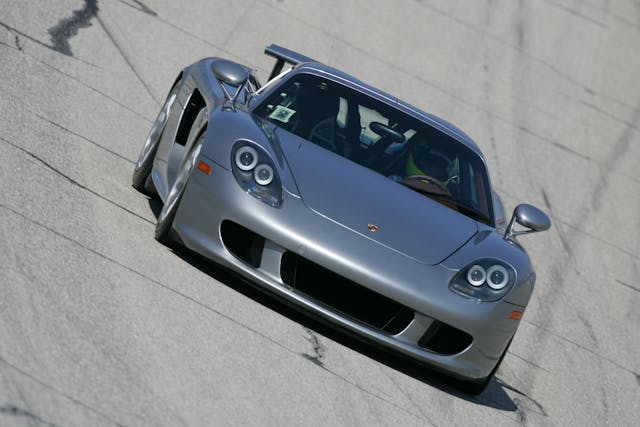
I was new to the high-end auction world but got the picture: keep the car and send a check for its value to Save the Children. I tried to quickly calculate the fallout at the office on Monday. I agreed to go along with the mercy bid strategy, which soon played itself out to an audience of mostly unoccupied seats. The mystery bid winner, a Porsche regional sales manager, was whisked away. If people noticed the charade, they didn’t mention it.
And so ended a series of stunts whose value could only be measured in the advertising equivalent of the media coverage they generated, which, in addition to an episode of Rides, included coverage in entertainment television and print coverage from the stalwart automotive press.
Back at PCNA HQ in Atlanta, Schwarzenbauer signed the check request for the value of the car, payable to Save the Children; the fallout from the mercy bid was minimal. I had weathered two political storms and one actual hurricane. A few weeks after the auction, I decided to leave PCNA for an opportunity outside the automotive industry. I, too, turned left. I have not seen a Carrera GT since. I remain grateful that no harm came to either Leno or Donohue, which was a greater risk than I understood at the time.

The whole publicity program, including the value of the donated car, cost the better part of a million dollars. Did it help PCNA move any units? Perhaps not even the one in which the records were set, but about half of the 1270 Carrera GTs produced ended up in U.S. garages. Despite the feats attributed to it, the silver Carrera GT from Talladega remained in inventory at PCNA, sometimes used for display, sadly not in its record-setting livery. Stored at PCNA’s Atlanta facility after the event, the U.S.-spec car was rumored to have been shipped back to Germany, either as a gift or a sale from PCNA to a former Porsche AG executive. Its whereabouts are unclear and its achievements—glorious or inglorious—may not be known to its current owner.
According to Hagerty Valuation, a 2005 Carrera GT in concours condition is worth $1.3 million. One in excellent condition brings $1 million, and the average transaction value is $880,000, twice the original MSRP. If you purchased one new in 2005, used it lightly and cared for it well, you’d have a 7.5 percent annual return on investment. The same amount in the S&P 500 over the same period would have netted more, but you wouldn’t have had a Carrera GT in the garage.
Much of the value increase has come in recent years, since the relatively large number produced initially hurt the car’s value. No speed record or amount of publicity can change economics; too much supply means lower prices, just like my old boss Schwab told me during my interview.

David Donohue continued to be involved with Porsche and the successor to the Carrera GT, the hybrid Porsche 918 Spyder supercar that debuted in 2014.
“When I got involved in the 918, value was my big concern. Perception is reality in this business, so you can have a million-dollar car, but if no one is going to pay for it, then it’s not worth that,” said Donohue. “When I was presenting the 918 to customers, they were constantly saying, ‘I’ll pick one up secondhand for cheap.’ They were thinking Carrera GT. The dealers were going to be out a lot of money if someone took a 918 to auction and it didn’t sell. Fortunately, that didn’t happen, but that’s exactly what happened with the Carrera GT.”
So why the recent increase in value of the Carrera GT? Maybe because collectors have awakened to the car’s place in history.
“It is the last truly analog Porsche,” said Leno, who purchased a Carrera GT in 2005. “It was the last modern manual design for a sports car. And it’s the best sounding Porsche ever. It’s almost the greatest sounding motor there is, right up there with the McLaren F1.
“All the truly great cars have some flaw; the Carrera GT was a car you needed to master. It’s a collectible. I truly enjoy it, and I will never get rid of mine.”
Check out the Hagerty Media homepage so you don’t miss a single story, or better yet, bookmark us.
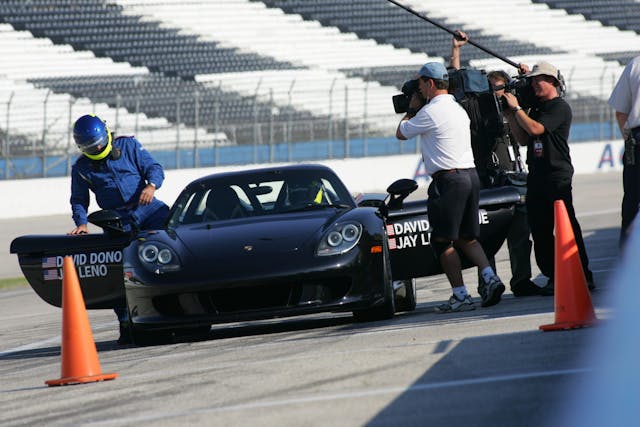

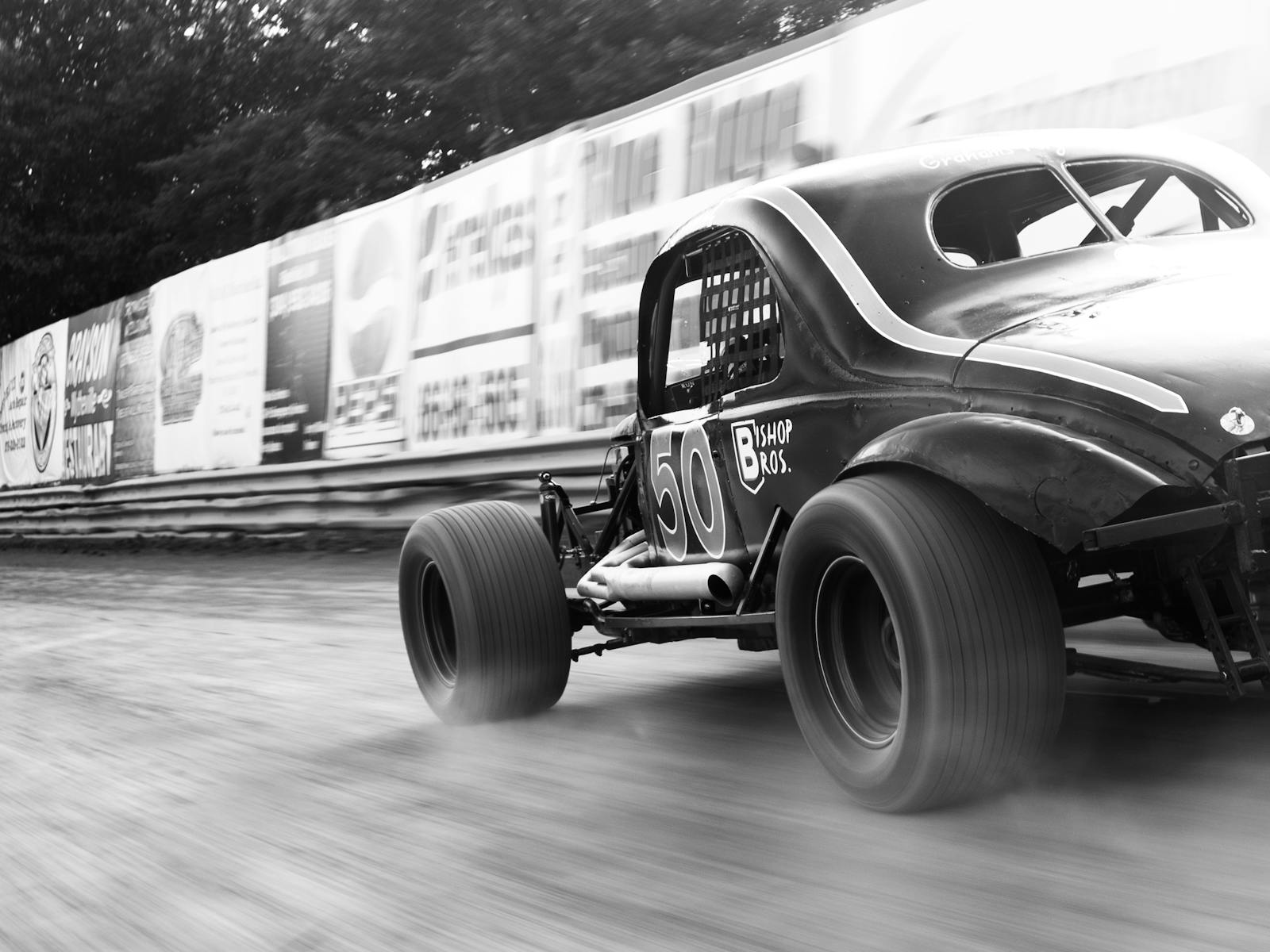
I met Jay Leno once at a car show. He stood for what seemed like over an hour in the 100 degree heat signing autographs and answering questions. This story is another example of what a genuinely good guy he is.
Like
Good story, thank you! I would mention one caveat to the stock market vs. buy-and-hold porsche return item:
if you DID earn that 7.5% in the market, you paid taxes on it when you pulled the money out, or possibly as you went along. There is no tax on the profit made from the selling of a privately owned car 🙂
Yeah, that statement is 100% incorrect.
While it is possible to raise the cost basis by any documented restoration work, any profit over the cost basis on the sale is treated as capital gains under the tax code.
Don’t take my word for it, ask Dr. Google.
Jay has always appeared to have a big heart for the Military and causes like the Victims of natural disasters. His willingness to go along on various car stunts like setting records is also fun to watch. he knows he may be the fish out of water but he enjoys it.
Great story!! Thank you for sharing this!
I wonder if the original sales problem with the Carrera GT was that its design was a visual mess; shouldn’t a supercar have some sort of beauty? I realise that doesn’t stop people from buying Bugattis these days….
And today that thing could be challenged (on straights) by a Miata that some YouTuber hopped up at home.
During my career as an HVAC service technician in the Hamptons I came across many a trophy vehicle and private collections, but the Carrera GT stands out above them all by far, as the caretaker for one of my customers actually let me drive one. I will NEVER forget the sound of that V-10 as I wound it up to 80mph in 2nd gear, scattering the joggers on Dune Road into the bushes! Sounded like F1 did in years gone by.